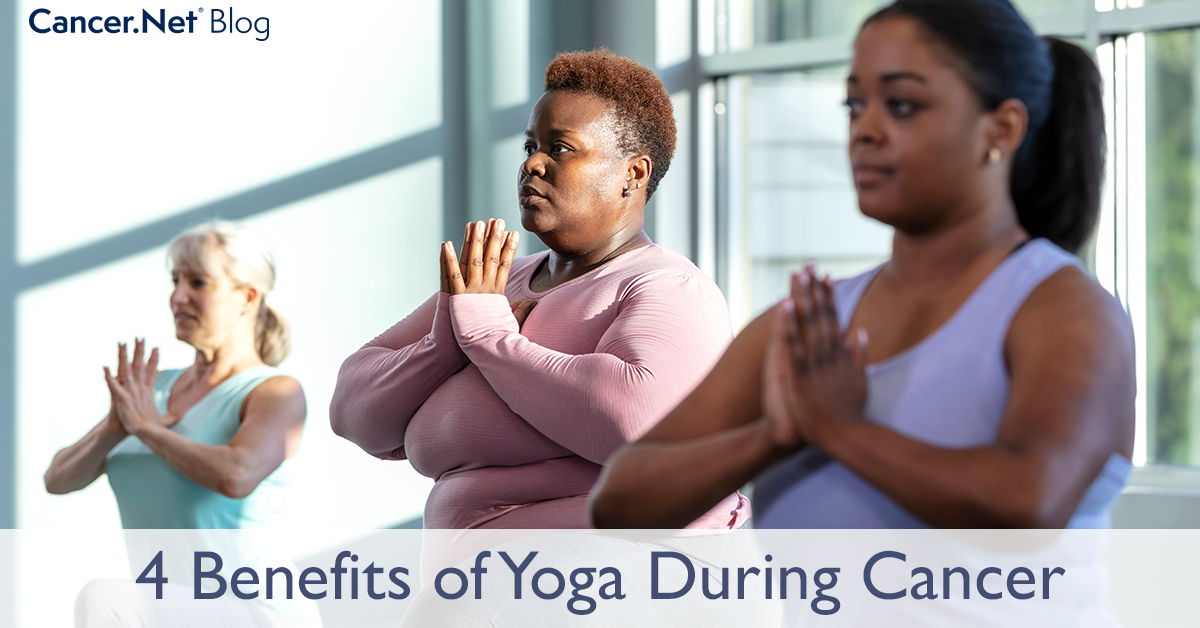
Kimberly Lowe, PhD, has spent her entire 20-year career as a cancer researcher trying to improve diagnostics and quality of care for people with cancer. She is also the founder of Empower You, which offers mind-body tools specifically for those affected by cancer, including yoga, meditation, nutrition, guided self-massage, guided energy medicine, and art classes. View Dr. Lowe’s disclosures.
Many people are drawn to yoga for its gentle but effective way of increasing our physical strength and flexibility while also calming our minds and emotions. If you just received a cancer diagnosis or are in the middle of active treatment, you may be wondering if yoga is right for you.
Among people living with cancer, common reasons I often hear for not doing yoga include:
“I’m in active treatment, and I’m not sure if it’s safe for me.”
“I don’t feel stable or balanced right now, so yoga feels risky.”
“I didn’t do yoga before my diagnosis and am nervous to try something new.”
“I’m too tired,” “I’m not flexible,” and “I don’t know how!”
Do any of those sound familiar to you? If so, once you understand the unique ways yoga can help you during your cancer experience, those doubts and fears may give way to curiosity and a new direction for how you exercise.
For people living with cancer, the many benefits and advantages of yoga can easily be overlooked. Once your doctor has given you the green light for exercise during or after cancer, there are 4 main reasons why you should consider adding yoga to your daily or weekly routine.
1: Yoga is good for the bones.
Some types of cancer and cancer treatments may cause bones to weaken, which can lead to an increased risk of fracture. Simple yoga poses help strengthen the bones in a gentle and supportive way. In fact, many of the traditional yoga poses are considered to be weight-bearing exercises. For example, all standing poses strengthen the leg bones, pelvis, and spine. Poses that require you to be on your hands and knees have the added benefit of strengthening your arm bones. In addition, many yoga poses can help you find alignment in your body, leading to improved spine strength, flexibility, and overall comfort.
2: Yoga is good for the immune system.
There are 10 main systems in the human body. The cardiovascular and digestive systems are commonly known and receive a lot of attention when we think about our general health. The lymphatic system, which is part of our immune system, may not be as well known, but it plays a major role in how our bodies detoxify and protect us from disease.
Unlike our cardiovascular system, which is propelled by our beating heart, the lymph fluid in our lymphatic system is circulated through the movement of our muscles. Lymph fluid travels through the lymphatic system and carries cells that help fight off infection and disease. Yoga puts our bodies into certain positions that help move lymph fluid towards the thoracic duct in the chest, where it will be processed and expelled back into the body. For example, if you put your arms up and over your head, as is done in many yoga poses, this encourages the lymph fluid in the arms to drain down. There are countless gentle ways yoga can help flush your lymphatic system to improve immunity and better health.
3: Yoga is good for our mood.
Many studies have shown that yoga positively impacts mental health, including reductions in anxiety and depression and improved quality of life. Receiving a cancer diagnosis can be scary for anyone, and the uncertainty that follows can be difficult to manage. Yoga is beneficial in reducing feelings of fear, anxiety, and being overwhelmed because certain poses are designed to engage the parasympathetic nervous system, also known as the “rest and digest system.” When turned on, this system triggers the relaxation response in our bodies, which can help us relax and even sleep better.
4: Yoga is good for the muscles.
Yoga poses range from gentle to intense. Aside from restorative poses, which are designed to engage the relaxation response described above, most poses require some form of movement or active stillness in a specific posture that will strengthen our muscles. People with cancer sometimes face challenges associated with scar tissue or side effects from treatment, and many yoga poses can help improve range of motion and flexibility, making daily living easier. The more active yoga poses have the added benefit of strengthening the cardiovascular system because they may require several muscles to maintain the pose. However, there are many gentle poses that are a fantastic way to help build strength and flexibility during and after treatment.
How to get started with yoga during cancer
If you feel inspired to start doing yoga after your cancer diagnosis, talk to your doctor first to make sure they agree yoga is safe and beneficial for you. If you’ve never done yoga before, remember that nobody knows how to do yoga when they first start! Start slow and give it a fair chance. You will be joining a supportive community of people who value peace, health, and personal empowerment.
More and more cancer treatment centers are offering yoga classes, and there are many yoga classes specifically for people affected by cancer available online. Most importantly, remember that yoga does not have to be difficult to be beneficial. Even a few minutes of moving your body with your breath in a mindful way can make a big difference in how you feel!






